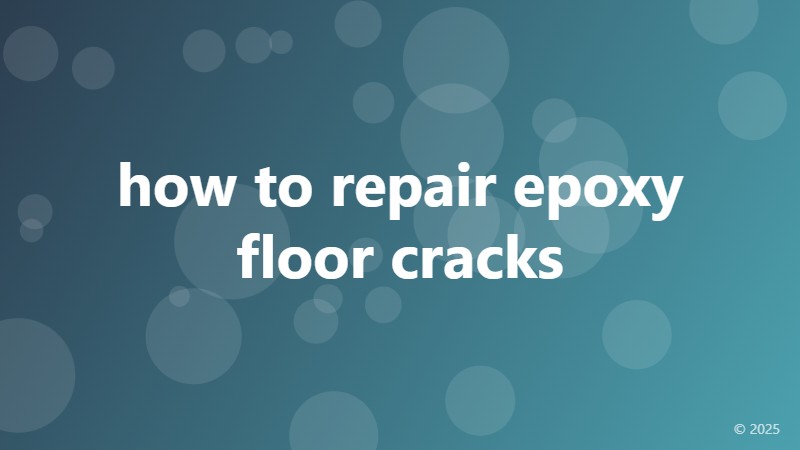how to repair epoxy floor cracks
 ```html
```html
Assessing the Damage: How Severe is Your Epoxy Floor Crack?
Before you even think about grabbing your tools, you need to accurately assess the extent of the damage. Small, hairline cracks in your epoxy floor are much easier to repair than large, gaping fissures. Knowing the severity will determine the best repair method and the materials you'll need. Look for signs of spalling (chipping) or significant depth to the crack. A simple visual inspection is usually sufficient, but for larger cracks, you might need a small probe to check the depth.
Gathering Your Supplies: Essential Tools and Materials for Epoxy Floor Crack Repair
The specific materials you'll need depend on the size and severity of the crack. However, some essentials remain consistent. Here’s a list to get you started:
- Epoxy Filler/Repair Kit: Choose a kit specifically designed for epoxy floors and matching the color of your existing floor as closely as possible. These kits typically include the epoxy resin and hardener.
- Mixing Cups and Sticks: Disposable cups and sticks are best to avoid contamination.
- Putty Knife or Spatula: To apply the epoxy filler accurately and smoothly.
- Sandpaper (various grits): For smoothing out the repaired area.
- Shop Vacuum: To remove dust and debris before and after sanding.
- Safety Glasses and Gloves: Always prioritize safety when working with epoxy.
- Optional: Crack Sealer (for larger cracks): This prevents further cracking and provides a solid base for the filler.
For deeper cracks, you may also need a drill with a masonry bit to create small holes along the crack to allow the epoxy to penetrate more effectively. This helps prevent the epoxy from simply sitting on the surface and creates a stronger bond.
Step-by-Step Guide: How to Repair Small Epoxy Floor Cracks
This method is suitable for hairline cracks and small fissures less than 1/8 inch wide.
- Clean the Crack: Thoroughly clean the crack with a shop vacuum and a stiff brush to remove any dirt, dust, or debris. This is crucial for optimal adhesion.
- Mix the Epoxy: Carefully follow the manufacturer's instructions for mixing the epoxy resin and hardener. Ensure a thorough and consistent mix to achieve the proper curing process.
- Apply the Epoxy: Use a putty knife or spatula to apply the epoxy filler into the crack, pressing it firmly to ensure it fills the void completely. Remove any excess epoxy.
- Smooth the Surface: Once the epoxy has slightly begun to set (check the manufacturer's instructions for cure time), use a damp sponge or cloth to smooth the surface. Avoid excessive pressure, as this can push the epoxy out of the crack.
- Sand and Finish: Once the epoxy is fully cured, use fine-grit sandpaper to smooth out any imperfections. Clean the area with a shop vacuum.
Repairing Larger Epoxy Floor Cracks: A More Involved Approach
Larger cracks require a more robust approach. These steps build upon the previous method:
- Clean and Prepare: Thoroughly clean the crack, remove loose debris and use a wire brush to widen the crack slightly (if necessary) to improve epoxy penetration.
- Crack Sealer (Optional): For deep cracks, consider applying a crack sealer to prevent further spreading and provide a stable base for the epoxy. Allow it to cure completely as per manufacturer's instructions.
- Drill Vents (for very deep cracks): Create small holes along the crack, spacing them approximately 4 inches apart. This will allow epoxy penetration and reduce stress.
- Apply Epoxy in Layers: Apply the epoxy filler in layers, allowing each layer to set slightly before adding the next. This prevents sagging and ensures complete filling. Use a caulking gun for ease of application.
- Smooth, Sand, and Finish: Once the epoxy is fully cured, follow the smoothing, sanding, and finishing steps as described above.
Preventing Future Epoxy Floor Cracks: Maintenance and Prevention
Regular maintenance can significantly extend the life of your epoxy floor and reduce the likelihood of cracking. This includes regular sweeping and mopping to remove dirt and debris, promptly addressing spills, and using floor mats in high-traffic areas. Avoid dragging heavy objects across the floor, and consider using protective floor coverings under heavy equipment.
When to Call a Professional: Knowing Your Limits
While many epoxy floor crack repairs are DIY-friendly, some situations warrant professional help. If you're dealing with extensive cracking, structural damage, or are unsure about the repair process, it's best to contact a qualified flooring professional. They possess the expertise and tools to handle complex repairs effectively and ensure a long-lasting result.
```